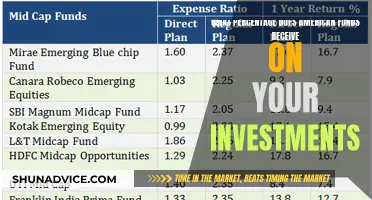
Investing in mutual funds through HDFC Netbanking is a simple process. First, you need to have an Investment Services Account (ISA) and complete your Central Know Your Customer (CKYC) requirements. Then, log in to your account, select the scheme you want to invest in, choose the number of units, and make the payment. The units will be automatically credited to your ISA account. You can also set up a Systematic Investment Plan (SIP) through Netbanking, which allows you to invest small amounts regularly. HDFC Bank offers a range of mutual funds, including Equity Funds, Debt Funds, and SIPs, providing a comprehensive and flexible way to create a diversified investment portfolio.
| Characteristics | Values |
|---|---|
| Types of Mutual Funds | Debt Funds, Equity Funds, Balanced Funds, Large Cap Funds, Mid-Cap Funds, Small Cap Funds, Multi-Cap Funds, ELSS Funds |
| Investment Options | Growth, Dividend, Lump Sum, SIP (Systematic Investment Plan) |
| Investment Methods | Online, Offline |
| Investment Accounts | CKYC (Central Know Your Customer), ISA (Investment Services Account), Demat Account |
| Investment Platforms | HDFC Bank's InvestNow, ISA |
| Investment Requirements | PAN (Permanent Account Number), Bank Account, CKYC, FATCA Form |
What You'll Learn

Risk vs. return
When considering how to invest in mutual funds through HDFC Netbanking, it is important to understand the relationship between risk and return. Mutual funds are a pool of money managed by professionals who invest in various financial instruments such as equities, bonds, and money market instruments. While investing in mutual funds, it is crucial to consider your financial goals and risk tolerance.
Different types of mutual funds carry varying levels of risk and potential returns. Debt funds are considered the least risky option, offering lower returns, while equity funds involve more risk with the potential for substantially higher returns. Balanced funds aim to strike a balance between risk and return. Within equity funds, large-cap funds invest in well-established companies, reducing risk compared to mid-cap funds, which are more volatile but can offer higher long-term returns.
When investing in mutual funds through HDFC Netbanking, you can utilise platforms like InvestNow and ISA (Investment Services Account) to gain expert recommendations based on your financial goals and risk appetite. These platforms enable you to compare returns and utilise rankings to find the best-suited mutual funds. Additionally, HDFC Netbanking allows you to track your mutual fund holdings and transactions directly.
It is important to remember that mutual fund investments are subject to market risks, and it is advisable to carefully read the scheme information and related documents before making any investment decisions.
Currency Hedge Funds: A Thing of the Past?
You may want to see also

Growth vs. dividend
When investing in mutual funds, you have two options: growth or dividend.
Growth
In the growth option, any profits made by the scheme are reinvested in the fund. This means that you may earn profits on profits and benefit from compounding. The NAV of the growth option will always be higher than the dividend option because the profits reinvested in the growth option may grow in value over time. The total returns of the growth option are usually higher than the dividend option over a long investment horizon due to the compounding effect. There is no taxation in the growth option unless you redeem. In equity funds, short-term capital gains (held for less than 12 months) are taxed at 15% and long-term capital gains (held for more than 12 months) of up to Rs 1 lakh are tax-exempt and thereafter, taxed at 10%.
Dividend
In the dividend option, profits made by the mutual fund scheme are paid out to investors at certain intervals. The most common dividend payout interval is annual, but some schemes also offer other payout intervals such as daily, monthly, or quarterly. Dividends paid by both equity and debt mutual funds are taxed in the hands of the investors at the applicable income tax slab rates of the investors. Income Tax Act provides for mandatory deduction of TDS @ 10% from dividend income in the case of Resident Individual. However, no TDS is deducted if the aggregate dividend distributed or likely to be distributed during the financial year to an individual unit holder does not exceed Rs 5,000.
The choice between these two options should be driven primarily by your financial goals and requirements. If you do not need regular cash flows, you may choose the growth option. On the other hand, if you need regular cash flows from your investments, then choose the dividend option.
A Guide to Investing in Mutual Funds via Zerodha
You may want to see also

Lump sum vs. SIP
When deciding between investing in mutual funds through a Systematic Investment Plan (SIP) or a lump sum, it is important to consider the differences between the two investment strategies. Both have their pros and cons, and the best option for you will depend on your financial situation, goals, and risk tolerance.
A lump sum investment is a one-time payment, whereas an SIP involves making recurring payments at regular intervals. Lump sum investments are typically chosen when an investor has a large amount of cash on hand, while SIPs are better for beginners as they benefit from both bullish and bearish markets through rupee cost averaging.
With SIPs, you can enter the market during different cycles as the investment is recurring, so you don't have to worry about timing the market. SIPs also have a low barrier to entry, with a minimum investment of Rs. 500, making them more accessible to new investors. Additionally, SIPs instil a habit of saving frequently and promote disciplined investing.
On the other hand, lump sum investments are generally preferred by experienced investors with a high-risk tolerance. The minimum investment for lump sum payments is Rs. 1000. Lump sum investments are ideal for short-term investment horizons, particularly in debt mutual funds, as SIPs are designed for long-term gains.
When deciding between the two, consider the amount you want to invest and your financial goals. If you have a significant amount to invest and are looking for short-term gains, a lump sum investment may be suitable. However, if you are trying to cultivate a savings habit and are less concerned with short-term market volatility, SIPs might be a better option.
Both SIPs and lump sum investments have their advantages, and it is not always an either-or decision. Depending on your situation, you may choose to utilise one or a combination of both strategies.
Mutual Fund Dividend Reinvestment: Powering Compounding Returns
You may want to see also

Online vs. offline
There are two ways to invest in mutual funds through HDFC: online or offline.
Online
Once you have your Central Know Your Customer (CKYC) requirements done, you can invest online. Most asset management companies allow you to invest online through their websites.
If you wish to invest online through HDFC, you will need to have an Investment Services Account (ISA). Investing through an ISA is simple. Just log into your account, select the scheme and the number of units you would like to buy, pay for your transaction, and you are done. The units will automatically get credited to your ISA account.
Offline
If you want to do it offline, you can visit a branch or office of the intermediary (like HDFC), fill up a simple form and invest in the Mutual Fund of your choice.
For SIP investments, fill an SIP form mentioning the number of instalments, amount of investment and date of investment and submit it along with a cheque for your first instalment. For the rest of the instalments, you can issue an ECS mandate, and future instalments will automatically be debited from your account.
Target Date Funds: A Guide to Investing for Retirement
You may want to see also

Direct vs. regular
When it comes to investing in mutual funds, there are two options: direct mutual funds and regular mutual funds. Here's a detailed comparison of the two:
Direct Mutual Funds
Direct plans are purchased directly from the fund house, and there is no broker or intermediary involved. This means there are no commission fees or distribution charges, resulting in a lower expense ratio. The expense ratio represents the fund's total expenses relative to its assets under management (AUM). Since there are no intermediary fees, the net asset value or NAV of direct mutual funds is higher than that of regular mutual funds. Direct funds also give you more control over your investments, and there are fewer chances of being misled by advisors. However, investing in direct funds requires you to do your own research and monitoring of your investment portfolio.
Regular Mutual Funds
Regular plans are purchased through intermediaries such as financial advisors or banks. These intermediaries charge commissions, which result in a higher expense ratio for regular funds. The higher expense ratio leads to slightly lower returns compared to direct funds. Regular funds are suitable for investors who need continuous support and guidance from financial advisors. Advisors assist in identifying suitable funds based on risk appetite, monitor the performance of the fund, and help in making investment decisions.
The choice between direct and regular mutual funds depends on your requirements and investment objectives. If you need regular guidance from a professional advisor and are willing to pay higher fees for their services, regular funds may be a good option. On the other hand, if you are looking for a cost-effective option with zero commission and want to earn maximum returns in the long term, direct funds would be a better choice.
Collaborative Fund Investment: Strategies for Success
You may want to see also







